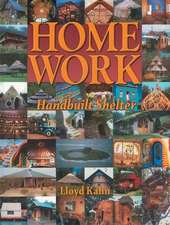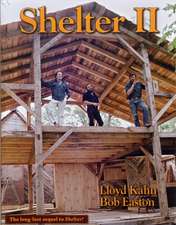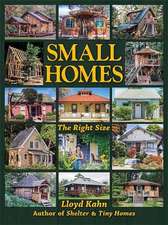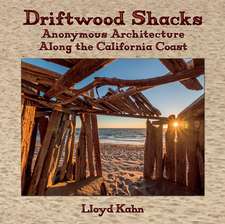Tiny Homes
Autor Lloyd Kahnen Limba Engleză Paperback – 31 dec 2011
There's a grassroots movement in tiny homes these days. The real estate collapse, the economic downturn, burning out on 12-hour workdays – many people are rethinking their ideas about shelter – seeking an alternative to high rents, or a lifelong mortgage debt to a bank on an overpriced home. Homes on land, homes on wheels, homes on the road, homes on water, even homes in the trees. There are also studios, saunas, garden sheds, and greenhouses.
There are 1,300 photos, showing a rich variety of small homemade shelters, and there are stories (and thoughts and inspirations) of the owner-builders who are on the forefront of this new trend in downsizing and self-sufficiency. You can buy a ready-made tiny home, build your own, get a kit or pre-fab, or live in a bus, houseboat, or other movable shelter. Some cities have special ordinances for building "in-law" or "granny flats" in the back yard. There are innovative solutions in cities, such as the "capsules" in Tokyo.
If you're thinking of scaling back, you'll find plenty of inspiration shown by builders, designers, architects, dreamers, artists, road gypsies, and water dwellers who've achieved a measure of freedom and independence by taking shelter into their own hands.
There are 1,300 photos, showing a rich variety of small homemade shelters, and there are stories (and thoughts and inspirations) of the owner-builders who are on the forefront of this new trend in downsizing and self-sufficiency. You can buy a ready-made tiny home, build your own, get a kit or pre-fab, or live in a bus, houseboat, or other movable shelter. Some cities have special ordinances for building "in-law" or "granny flats" in the back yard. There are innovative solutions in cities, such as the "capsules" in Tokyo.
If you're thinking of scaling back, you'll find plenty of inspiration shown by builders, designers, architects, dreamers, artists, road gypsies, and water dwellers who've achieved a measure of freedom and independence by taking shelter into their own hands.
Preț: 226.12 lei
Nou
Puncte Express: 339
Preț estimativ în valută:
43.27€ • 45.01$ • 35.72£
43.27€ • 45.01$ • 35.72£
Carte disponibilă
Livrare economică 20-26 martie
Livrare express 08-14 martie pentru 29.59 lei
Preluare comenzi: 021 569.72.76
Specificații
ISBN-13: 9780936070520
ISBN-10: 0936070528
Pagini: 214
Ilustrații: colour and black and white
Dimensiuni: 229 x 305 x 20 mm
Greutate: 0.99 kg
Ediția:NONE
Editura: Shelter Publications
ISBN-10: 0936070528
Pagini: 214
Ilustrații: colour and black and white
Dimensiuni: 229 x 305 x 20 mm
Greutate: 0.99 kg
Ediția:NONE
Editura: Shelter Publications
Cuprins
Tiny Homes on Foundations
For the Love of Snow . . . 2
The Sugar Shack . . . 12
Little House in the Backyard . . . 14
The Field Lab . . . 18
LaMar’s $2,000 Solar Cabin . . . 20
The Shed of Reality . . . 22
Backyard Chicken Coop Yacht . . . 24
House for One Person . . . 28
14´ × 14´ Post and Beam . . . 30
Rich in the Woods . . . 32
$1,000 Cabin on the Coast . . . 33
Art’s Bedroom . . . 34
Small Structures . . . 36
The Phoenix Commotion . . . 38
Ons Tweede Huis . . . 40
Kim & Jonny’s Cabin . . . 42
Tiny Texas Houses . . . 44
Rethinking Normal . . . 50
Friends in High Places . . . 51
Tiny Homes on Wheels
Jalopy Cabins . . . 52
Tumbleweed Tiny Houses . . . 54
Little House on the Trailer . . . 58
Oregon Cottage Company . . . 60
Jenine’s Two Tiny Houses . . . 62
ProtoHaus . . . 66
Building a Tiny House on Wheels . . . 68
Pallet House Project . . . 69
Tiny Homes by Architects
Judith Mountain Cabin . . . 70
Prefab Cottage . . . 72
Jeffery Broadhurst . . . 74
Tokyo Capsule Hotel . . . 78
TYIN Tegnestue Architects . . . 80
weeHouses . . . 82
Prefabs and Kits
Reclaimed Space . . . 84
Small House Innovation . . . 86
Bungalow in a Box . . . 87
Cabana Village . . . 88
YardPods . . . 89
Montana Mobile Cabins . . . 90
Tom’s Cabin . . . 92
More Prefabs & Kits . . . 94
Online Building . . . 98
Earthy Materials
Hani’s Man Cave . . . 100
Bill and Athena Steen . . . 102
Hobbit House in Wales . . . 108
Ziggy’s Cob Cottage . . . 110
The Laughing House . . . 114
The Mudgirls of BC . . . 116
Pallet/Cob Backyard Shed . . . 119
Straw Bale / Cob House in Oregon . . . 120
Cobworks . . . 122
Cob/Wood Roundhouse in Wales . . . 126
Dogon Dome . . . 128
Big Sky Yurt . . . 130
Sauna on Haida Gwaii . . . 132
Baja Surfer’s Shack . . . 134
Ardheia . . . 136
Solar Potting Shed . . . 144
Driftwood Beach Shack . . . 146
Bouncing Bridge with Troll Booth . . . 148
Treehouses
Crystal River Treehouse . . . 150
Treebane . . . 154
Lapas Nest Treehouse . . . 156
Lakeside Treehouse . . . 160
Deek Diedrickson . . . 162
Taylor Camp . . . 164
On the Road
Lloyd’s Van . . . 166
Hornby Island Caravans . . . 168
The Flying Tortoise . . . 170
Vardo /Sheep Wagon . . . 172
Simplify, Simplify . . . 174
Nicolette’s € 1,000 Wagen . . . 176
ProtoStoga . . . 178
Jay Nelson . . . 180
Baja Road Travel . . . 182
Big Red . . . 183
Artist in a Van . . . 184
Lady on the Road . . . 186
Bernie Harberts’ Covered Wagon . . . 188
The Horsebox House . . . 190
American Nomad Rigs . . . 192
Vintage Campers . . . 196
On the Water
Paul, Julie, and Mia on the High Seas . . . 198
Sailing Yacht “Misty”. . . 204
Floating Homestead in BC . . . 206
Ontario Boathouse . . . 208
Our Little Cabin up the Lake. . . 210
Narrowboats . . . 212
Recenzii
"…our friend Lloyd Kahn's beautiful book, Tiny Homes."
—Mark Frauenfelder, BoingBoing
"Tiny Homes is an amazing collection. ...The homes might be tiny but your inspiration is huge."
—Richard Zanuck, Film Producer
"...a quirky photo-rich book that preaches the benefits of a 'grassroots movement to scale things back.'"
—Jeffery Trachtenberg, Wall Street Journal
"...a glorious portfolio of quirky makers and dreamers..."
—Penelope Green, New York Times
"Before McMansions, before the counter culture was granite and marble, there was Lloyd Kahn, champion of the hand-built house . . . progenitor of the new do-it-yourself movement"
—Patricia Leigh Brown, New York Times
"The common thread that weaves between the stories is the builders' immense pride of place, a drive for independence and a vision that, when little goes to waste, life can have greater meaning."
—HomeGrown.Org
" ...a refreshing view into the wonderful world of small houses."
—Watershed Sentinel, BC, Canada
"...splendid photos of home exteriors, interiors and landscapes..."
—Urban Times
"What these structures might lack in square footage they more than make up for in economy, character and appeal..."
—U-T San Diego
Notă biografică
"I started building almost 50 years ago, and have lived in a self-built home ever since. If I’d been able to buy a wonderful old good-feeling house, I might have never started building. But it was always cheaper to build than to buy, and by building myself, I could design what I wanted and use materials I wanted to live with.
I set off to learn the art of building in 1960. I liked the whole process immensely. Hammering nails. Framing — delineating space. Nailing down the sub-floor, the roof decking. It’s a thrill when you first step on the floor you’ve just created.
Ideally I’d have worked with a master carpenter long enough to learn the basics, but there was never time. I learned from friends and books and by blundering my way into a process that required a certain amount of competence. My perspective was that of a novice, a homeowner — rather than a pro. As I learned, I felt that I could tell others how to build, or at least get them started on the path to creating their own homes.
Through the years I’ve personally gone from post and beam to geodesic domes to stud frame construction. It’s been a constant learning process, and this has led me into investigating many methods of construction — I’m interested in them all. For five years, the late ’60s to early ’70s, I built geodesic domes. I got into being a publisher by producing Domebook One in 1970 and Domebook 2 in 1971. I then gave up on domes (as homes) and published our namesake Shelter in 1973. We’ve published books on a variety of subjects over the years, and returned to our roots with Home Work: Handbuilt Shelter in 2004, Builders of the Pacific Coast, and The Barefoot Architect in 2008.
Building is my favorite subject. Even in this day and age, building a house with your own hands can save you a ton of money (I’ve never had a mortgage) and — if you follow it through — you can get what you want in a home." —Lloyd Kahn
I set off to learn the art of building in 1960. I liked the whole process immensely. Hammering nails. Framing — delineating space. Nailing down the sub-floor, the roof decking. It’s a thrill when you first step on the floor you’ve just created.
Ideally I’d have worked with a master carpenter long enough to learn the basics, but there was never time. I learned from friends and books and by blundering my way into a process that required a certain amount of competence. My perspective was that of a novice, a homeowner — rather than a pro. As I learned, I felt that I could tell others how to build, or at least get them started on the path to creating their own homes.
Through the years I’ve personally gone from post and beam to geodesic domes to stud frame construction. It’s been a constant learning process, and this has led me into investigating many methods of construction — I’m interested in them all. For five years, the late ’60s to early ’70s, I built geodesic domes. I got into being a publisher by producing Domebook One in 1970 and Domebook 2 in 1971. I then gave up on domes (as homes) and published our namesake Shelter in 1973. We’ve published books on a variety of subjects over the years, and returned to our roots with Home Work: Handbuilt Shelter in 2004, Builders of the Pacific Coast, and The Barefoot Architect in 2008.
Building is my favorite subject. Even in this day and age, building a house with your own hands can save you a ton of money (I’ve never had a mortgage) and — if you follow it through — you can get what you want in a home." —Lloyd Kahn
Extras
RETHINKING NORMAL
Tammy Strobel
Tammy Strobel is an author (Simply Car-free and Smalltopia), website designer, and media consultant living in Sacramento, California with Logan. Here she describes the downsizing of their possessions and the difference it made in their lives.
Five years ago, we lived the “normal middle class” suburban lifestyle. We were newlyweds with flashy rings, living in a two-bedroom apartment, driving two cars, commuting long distances to work and living well beyond our means.
We were living in Davis, California, which is notorious for expensive real estate and a negative vacancy rating (more people than rooms). In reflection, we had a life with too much stuff and stress.
Initially, we resisted the idea of moving into a smaller one bedroom apartment because we were more concerned about appearances and space for guests than for our financial well being. Realizing the source of our stress was our financial situation, we decided something needed to change. This “change” began by defining our values and prioritizing our needs over those of potential future guests.
After creating many long pro/con lists, the scaling down process began. We sold one car and moved into a one-bedroom apartment near the train station, the grocery store and downtown amenities. Driving everywhere was still a big part of our lives, but with lower rent we began chipping away at our debt. Our lives began to change for the better.
It wasn’t until last year that we stumbled across Dee Williams’s tiny house, the Small House Movement, and the concept of simple living. After doing a lot of research and making many to-do lists, we decided to move from Davis to mid-town Sacramento. We scaled down even further, to a 400-square-foot, one-bedroom apartment within walking distance to my work. Dee inspired me to go small and start thinking big.
Thinking big required setting goals and decluttering. Slowly we began focusing on the quantity and quality of our belongings.
Downsizing can be stressful, but the benefits are tremendous. Moving to a smaller apartment in the city opened up amazing possibilities. Once we sold our one remaining car, life became even better because we saved money and worked less. It sounds like a cliché, but without the car and the TV, we had the time, money and energy to prioritize our health, happiness and life goals.
Below are a few tips that worked for us:
Good luck in your own simple living quest. Above all, pursue happiness and not more stuff.
Tammy Strobel
Tammy Strobel is an author (Simply Car-free and Smalltopia), website designer, and media consultant living in Sacramento, California with Logan. Here she describes the downsizing of their possessions and the difference it made in their lives.
Five years ago, we lived the “normal middle class” suburban lifestyle. We were newlyweds with flashy rings, living in a two-bedroom apartment, driving two cars, commuting long distances to work and living well beyond our means.
We were living in Davis, California, which is notorious for expensive real estate and a negative vacancy rating (more people than rooms). In reflection, we had a life with too much stuff and stress.
Initially, we resisted the idea of moving into a smaller one bedroom apartment because we were more concerned about appearances and space for guests than for our financial well being. Realizing the source of our stress was our financial situation, we decided something needed to change. This “change” began by defining our values and prioritizing our needs over those of potential future guests.
After creating many long pro/con lists, the scaling down process began. We sold one car and moved into a one-bedroom apartment near the train station, the grocery store and downtown amenities. Driving everywhere was still a big part of our lives, but with lower rent we began chipping away at our debt. Our lives began to change for the better.
It wasn’t until last year that we stumbled across Dee Williams’s tiny house, the Small House Movement, and the concept of simple living. After doing a lot of research and making many to-do lists, we decided to move from Davis to mid-town Sacramento. We scaled down even further, to a 400-square-foot, one-bedroom apartment within walking distance to my work. Dee inspired me to go small and start thinking big.
Thinking big required setting goals and decluttering. Slowly we began focusing on the quantity and quality of our belongings.
Downsizing can be stressful, but the benefits are tremendous. Moving to a smaller apartment in the city opened up amazing possibilities. Once we sold our one remaining car, life became even better because we saved money and worked less. It sounds like a cliché, but without the car and the TV, we had the time, money and energy to prioritize our health, happiness and life goals.
Below are a few tips that worked for us:
- Going small. Downscaling to a tiny one-bedroom was a slow process that required a lot of work and many trips to the thrift store. Moving into a 400-square-foot apartment forced us to declutter our lives and seriously question why we needed so much stuff.
- Divorcing our car. After months of talking about the pros and cons of selling our car, we decided to follow in the footsteps of a Wisconsin graduate student and divorce our car.
- Becoming debt-free is indescribably liberating. Discovering the concept of simple living helped us become debt-free. After giving away the TV and selling our car, we realized how many hidden ownership costs we were paying. We also discovered an amazing book, called Your Money or Your Life, that fundamentally changed our relationship with money.
- Happiness counts. Purging our lives of clutter and debt has not only made us happier, but we have purchased less stuff. Since we started the downsizing process, we feel psychologically “lighter.” Since we eliminated our debt, I know I have options to engage in activities that make me happy. For instance, I’m a lucky person and enjoy my job. But if I didn’t like it, I wouldn’t have to be tied to the position. That is a huge bonus of being debt-free and actually having money in savings.
- Downsizing is a process, and it doesn’t happen overnight. I hope our personal story will help you remove clutter from your life, one step at a time.
Good luck in your own simple living quest. Above all, pursue happiness and not more stuff.











